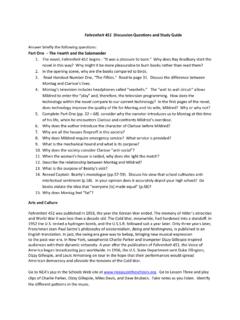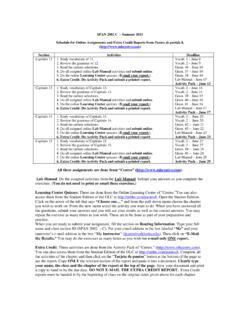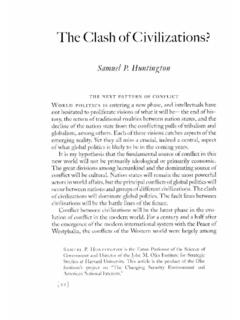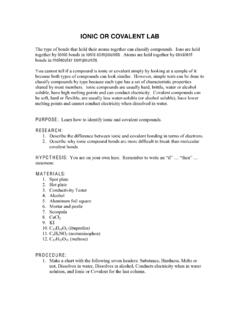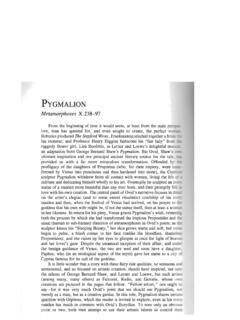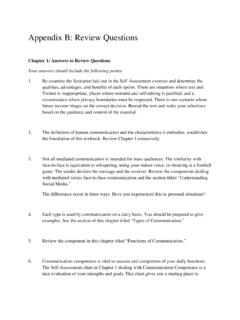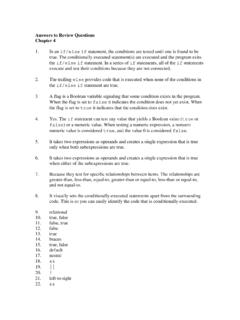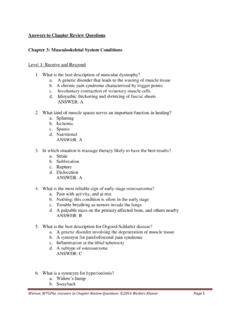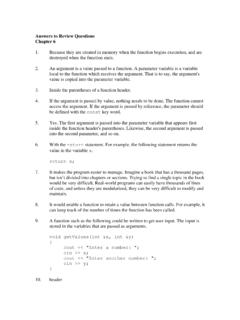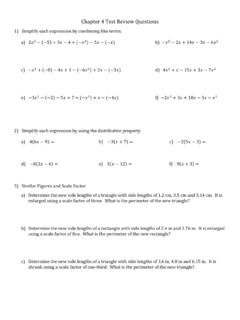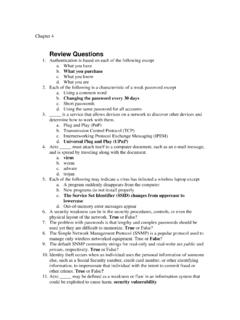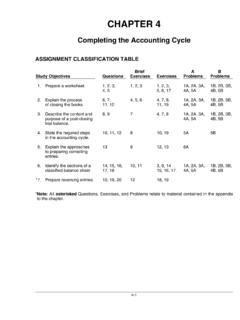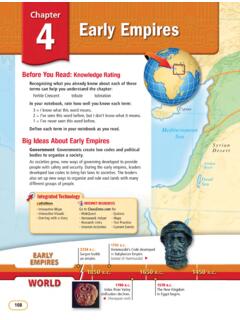Transcription of Chapter 4 ANSWER KEY - Quia
1 Chapter 4 Structures and Properties ofSubstancesSolutions for Practice ProblemsStudent Textbook pages 165 electron configurations for the following:(a)Li+(b)Ca2+(c)Br (d)O2 SolutionFirst determine the atomic number of the ion, and then add or subtract electrons tomatch the charge indicated on the ion. Use the aufbau process to write the completeelectron configuration of the ion.(a)Li+:Z=3, subtract one electron for +1charge; 1s2(b)Ca2+:Z=20, subtract two electrons for +2 charge; 1s22s22p63s23p6(c)Br :Z=35, add one electron for charge of 1; 1s22s22p63s23p64s23d104p6(d)O2 :Z=8, add two electrons for charge of 2; 1s22s22p6 Check Your SolutionA check of the sequence of orbitals shows that the aufbau process was followed correctly. The number of electrons in each electron configuration matches the difference of Z (net charge on ion).
2 The answers are correct. 2. ProblemDraw Lewis structures for the chemical species in question a Lewis structure, the nucleus and the inner core electrons are represented by thesymbol for the element. The electrons in the valence shell are drawn around the symbol.(a)(b)(c)(d)Check Your SolutionEach positive ion shows no electrons. This is expected, since electrons were removedfrom the valence shell. Each negative ion has 8 valence electrons. This is expected forall ions except helium-like orbital diagrams and Lewis structures to show how the following pairs of elements can combine. In each case, write the chemical formula for the each example, electrons are transferred from the metal to the non-metal so thateach ion attains a noble gas electron O Br 2+Ca+Li36 Chapter 4 Structures and Properties of Substances MHRCHEMISTRY 12(a)Lewis structure: (b)Lewis structure: (c)Lewis structure: (d)Lewis structure: Check Your SolutionIn each case the ions have a noble gas electron configuration that takes into accountthe charge on the ion.
3 The answers are correct. 1s2s2pN 1s2s2p 3sNa 1s2s2p 3sNa 1s2s2p 3sNa 1s2s2pNa+ 1s2s2pNa+ 1s2s2pN3 1s2s2pNa++Na+Na+Na+ N N Na Na Na 3 1s2s2pCl 1s2s2p 3s3p 3s3p 3s 4s3p 3s3pK 1s2s2pCl 1s2s2pK++Cl + Cl KK 1s2s2p 3s3pCl 1s2s2pCl 1s2s2p 3s3p 3s3p 3s3p 3s 4s3p 3s3pCa 1s2s2pCl 1s2s2pCl 1s2s2pCa2++Ca 2+ Cl Cl Ca Cl Cl 1s2sLi 1s2s3pLi 1s2s2p 3s3p3sS 1sLi+ 1sLi+ 1s2s2pS2 S Li+S Li+Li+ Li2 37 Chapter 4 Structures and Properties of Substances MHRCHEMISTRY which main group on the periodic table
4 Does X belong?(a)MgX(b)X2SO4(c)X2O3(d)XCO3 SolutionSince these compounds are all ionic, the zero sum rule applies, and the sum of thecharges on the ions must equal zero. Once you know the charge on the ion, it can be related to the characteristic charge on ions for the main group elements.(a)The charge on Mg is +2. Therefore, (+2) +x= 0, and x= 2. X2 will be ingroup 16.(b)The charge on SO4is 2. Therefore, 2(x) +( 2) =0, and x= +1. X+will be ingroup 1.(c)The charge on O is 2. Therefore, 2(x) +3( 2) =0, and x= +3. X3+will be ingroup 3.(d)The charge on CO3is 2. Therefore, x+( 2) =0, and x= +2. X2+will be ingroup Your SolutionIn each case the zero sum rule holds. The charge on each X ion has been determinedcorrectly. Solutions for Practice ProblemsStudent Textbook pages 169 the following compounds in order of decreasing bond energy: H Br, H I,H Cl.
5 Use Appendix E to verify your all bonds are electrical in nature, a greater difference in charge between two atoms indicates a stronger attraction between the atoms, and therefore, a stronger bond. The difference in charge can be estimated using the property of electronegativity. A greater difference in electronegativity between the two atoms inthe bond indicates a greater attraction between the atoms. (A greater electronegativityalso indicates a greater ionic character of the bond.) For each bond, measure the difference in electronegativity, ( EN). The greater EN, the stronger the Cl: EN= = Br: EN= = I: EN= = upon these calculated values for EN, H Cl has greatest bond energy andH I has the least bond energy. From Appendix E, the bond energies confirm Cl: bond energy =432 kJ/molH Br: bond energy =366 kJ/molH I: bond energy =298 kJ/molCheck Your SolutionSince the measured value of bond energy matches the prediction using EN, this is avalid method to estimate bond 4 Structures and Properties of Substances MHRCHEMISTRY the following compounds in sequence from lowest melting point to highestmelting point, and give reasons for your decisions: AsBr3, KBr, compounds that are composed of a metal ion and a non-metal ion melt, thetwo types of ions are separated.
6 The greater the attraction between the ions, the moreheat energy will be required to melt the compound. The attraction between ions canbe estimated by calculating the difference in electronegativity ( EN) between theatoms (ions) in each upon this EN, the melting points will be expected to increase from AsBr3<CaBr2< Your AnswerThe actual melting points of these three compounds can be found in a reference textsuch as the Handbook of Chemistry and Physics. A check of this reference confirmsthat the reasoning was their position in the periodic table, predict which bond in the following groupsis the most polar. Verify your predictions by calculating the EN.(a)C H, Si H, Ge H(b)Sn Br, Sn I, Sn F(c)C O, C H, C NSolutionA greater distance between the positions of two elements in the periodic tableindicates a greater expected difference in the atoms ability to attract , a greater distance between elements in the periodic table indicates that amore polar bond forms between the elements.
7 Using these criteria, the most polarbond in each group is predicted to be:(a)C H(b)Sn F(c)C OUsing the electronegativities given on the periodic table, the following ENarefound:(a)C H ( ), Si H ( ), Ge H ( )(b)Sn Br ( ), Sn I ( ), Sn F ( )(c)C O ( ), C H ( ), C N ( )Our predictions were Your SolutionGenerally, the statement that the further apart two elements are found in the periodic table, the more polar the bond between them, is reliable. The use of EN,however, is a more accurate measure of the bonding in each of the following as covalent (non-polar), polar covalent,or ionic. Afterwards, rank the polar covalent compounds in order of increasing polarity.(a)S8(b)RbCl(c)PF3(d)SCl2(e)F2( f)SF2 KBrAsBr3 CaBr2 EN= EN= EN= 4 Structures and Properties of Substances MHRCHEMISTRY 12 SolutionCalculate the difference in electronegativity, EN, between the elements in each compound.
8 Apply the criteria that for a mostly covalent bond, ENis < ; for apolar covalent bond, ENis between and ; and for an ionic bond EN> covalent compounds: SCl2<SF2<PF3 Check Your SolutionThe type of bond predicted correlates with the relative positions of the elements inthe periodic table. These results are good indicators of the polarity of the bonds. Solutions for Practice ProblemsStudent Textbook page Lewis structures for each of the following molecules or ions:(a)NH3(b)CH4(c)CF4(d)AsH3(e)BrO (f)H2S(g)H2O2(h)ClNOSolution(a)The molecular formula, NH3, gives the number of each kind of atom. Followsteps 1 3 as given in the student 1 Nitrogen has the lower electronegativity in the molecule and will be thecentral 2 Determine the total number of valence electrons.(1 atom N 5e /N) +(3 atoms H 1e /H) =8 e Determine the total number of electrons required for a noble gas configuration.
9 (1 atom N 8e /atom) +(3 atoms N 2e /atom) =14 e To find the number of shared electrons, subtract the first total from e 8 e =6 e Divide the number of shared electrons by two to obtain the number e 2 =3 covalent bondsStep 3 Determine the number of non-bonding electrons by subtracting the number of shared electrons from the total number of valence electrons:8 valence e 6bonding e =2 e , or 1 lone pair NHHHNHHH ENType of bondingcovalentionicpolar covalent/ionicpolar covalentcovalentpolar covalentSRbClPFSClFSF(a) (b) (c) (d) (e) (f) 0=00 0= 4 Structures and Properties of Substances MHRCHEMISTRY 12(b)The molecular formula, CH4, gives the number of each kind of atom. Followsteps 1 3 as given in the student 1 Carbon has the lower electronegativity in the molecule and will be the central 2 Find the total number of valence electrons.
10 (1 atom C 4e /C)+(4 atoms H 1e /H)=8e Determine the total number of electrons required for a noble gas configuration.(1 atom N 8e /atom)+(4 atoms H 2e /atom)=16 e Determine the total number of electrons used in e 8e =8e , or 4 covalent bondsStep 3 Determine the number of non-bonding valence e 8 bonding e =0 non-bonding e (c)The molecular formula, CF4, gives the number of each kind of atom. Follow steps1 3 as given in the student 1 Carbon has the lower electronegativity in the molecule and will be the central 2 Calculate the total number of valence electrons. (1 atom C 4e /C)+(4 atoms F 7e /F)=32 e Determine the total number of electrons required for a noble gas atoms 8 e /atom =40 e Determine the total number of electrons used in e 32 e =8e , or 4 covalent bondsStep 3 Calculate the number of non-bonding valence e 8 bonding e =24 e , or 12 lone pairs(d)The molecular formula, AsH3, gives the number of each kind of atom.
